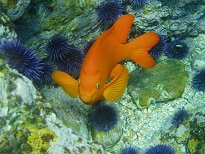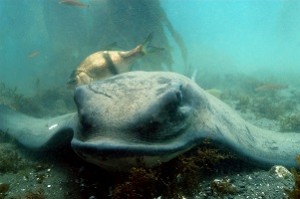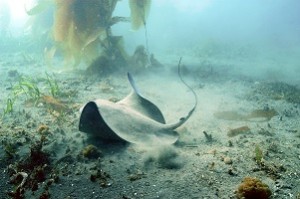Overview
Over 400 species of fish have been documented in the Channel Islands National Marine Sanctuary. The great diversity of fishes in the area occurs for three principal reasons: 1) the ranges of many cold temperate and warm temperate species extend into and terminate in the Southern California Bight; 2) the area has complex bottom topography and a complex physical oceanographic regime that includes several water masses and a changeable marine climate (Cross and Allen 1993; Horn and Allen 1978); and 3) the islands and nearshore areas provide a diversity of habitats including soft bottom, rocky reefs, extensive kelp beds, estuaries, bays, and lagoons.

The fish species found around the Channel Islands generally are representative of fish assemblages occurring along the southern California coast, with the addition of some central California species (Hubbs 1974). Abundance of fish assemblages is greater at the northern Channel Islands than at nearby coastal regions of the southern California mainland. Regional upwelling carries nutrient-rich waters from canyons and island shelf areas to surface waters. This results in increased primary productivity and large zooplankton populations, which support abundant populations of small schooling species, such as the northern anchovy, Pacific saury, sardine and mackerel. Larger pelagic (open water) fish prey upon these small schooling species, and together they form a significant contribution to the diet of marine mammals and birds. Island-associated pelagic fish are commonly consumed by pinnipeds and toothed whales.
Fishes commonly found in the sanctuary include: albacore, anchovy (northern), barracuda (Pacific), bass (various species), bat ray, blacksmith, bocaccio, bonito (Pacific), brown smoothhound, butterfish (Pacific), California scorpionfish, cabezon, California sheephead, California moray, California flyingfish, California halibut, croaker (various species), garibaldi, goby (various species), greenling (various species), grunion, gunnel, hake, Pacific half moon, horn shark, jacksmelt, kelpfish (various species), mackerel (various species), monkeyface prickleback, northern ronquil, ocean sunfish, opah, opaleye, orangethroat pikeblenny, queenfish, reef perch, rock wrasse, rockfish (various species), ronquil, stripedfin, salmon (king), sanddab, sarcastic fringehead, sardine (Pacific), sargo, saury, Pacific sculpin, seaperch (various species), señorita, shark (various species), silversides, sole (various species), spotted cusk-eel, surfperch (various species), swordfish, thornback, topsmelt, tube snout, turbot (various species), white sea bass, whitespotted greenling, yellowfin fringehead, and zebra perch.


Photos
Maps
Projects
Biogeographic Assessment of the Channel Islands National Marine Sanctuary
The Channel Islands National Marine Sanctuary (CINMS) off the coast of Southern California was designated in 1980. In 2005, NOAA's Office of National Marine Sanctuaries and CINMS were considering six alternatives for adjusting the sanctuary's boundaries. Identifying how the six options overlaid with the distribution of marine resources was a critical consideration. To address this need, we conducted a biogeographic assessment.
California Cooperative Oceanic Fisheries Investigations (CalCOFI)
The California Cooperative Oceanic Fisheries Investigations (CalCOFI) was formed in 1949 to study the ecological aspects of the Pacific sardine population collapse off California. Today, the focus has shifted to the study of the marine environment off the coast of California, the management of its living resources, and monitoring the indicators of El Nino and climate change.
California Lost Fishing Gear Recovery Project
The California Lost Fishing Gear Recovery Project was started in July 2005 by the SeaDoc Society (UC Davis Wildlife Health Center). Since its inception, the Project has recovered more than 100 tons of lost fishing gear and other marine debris. The California Lost Fishing Gear Recovery Project proposes to continue to help reduce the potential impact of lost fishing gear on living marine resources and underwater habitat by retrieving lost fishing gear from Channel Islands National Marine Sanctuary (CINMS) and anywhere on the coast where it is a high priority for removal because of demonstrated or potential impacts to marine wildlife and people. 1-888-491-GEAR to report lost, abandoned, and discarded gear.
Channel Islands Naturalist Corps
Channel Islands Naturalist Corps volunteers are trained by CINMS and CINP to educate the public on board local marine excursion vessels conducting whale watch tours, natural history tours, and island trips. Channel Islands Naturalist Corps volunteers are trained to conduct citizen science on marine mammal field identification and general research. Research objectives of the program include the development of a comprehensive database of incidental marine mammal sightings and reports collected in the Santa Barbara Channel, CINMS and CINP.
CINMS Soundscape monitoring
Biological, geophysical, and anthropogenic sound sources all combine to make up an underwater acoustic environment, or “soundscape.” Because ocean water conducts light very poorly and conducts sound very well, many marine organisms rely on sound for communication, navigation, reproduction, and foraging. Using a network of moored hydrophones around the sanctuary, we can examine how soundscapes vary at each location and across sanctuary habitats.
Ecology and management of the giant sea bass (Stereolepis gigas)
Research on the movement and spatial ecology of Stereolepis gigas, the giant sea bass, is part of a broader collaborative study on the ecology and population dynamics of S. gigas in the Northern Channel Islands, involving population monitoring, population modeling, economic valuation, and food web modeling.
Giant Sea Bass Monitoring at Anacapa Island
The objective of this project is to identify habitat preferences, home range, and behavioral patterns of giant sea bass. In order to investigate these topics we are looking at 5 main questions: o Where do giant sea bass aggregate? o What habitats are occupied by giant sea bass? o What are the home range sizes of giant sea bass? o How much and where do giant sea bass move during the year? o What are the behavioral patterns of giant sea bass?Giant Sea Bass Tracking Project
Partners: UC Santa Barbara, Cal State Long Beach
Giant sea bass (Stereolepis gigas) are large, soniferous apex predators of the kelp forest ecosystem. This project around Santa Barbara Island (SBI) utilizes a comprehensive array of acoustic telemetry receivers and external tagging of S. gigas to understand their movements around the islands. This work is in conjunction with the installation of soundtraps in order to gain a better understanding of the soundscape around SBI and the impact of sound on Giant Sea Bass in the region.
Partnership for Interdisciplinary Studies of Coastal Oceans (PISCO) Kelp Forest Monitoring – Santa Barbara Channel Region
PISCO’s kelp forest monitoring programs are designed to reveal geographic patterns of the structure and functions of this important ecosystem through quantification of the abundance of the macroalgae, invertebrates and fishes that constitute kelp forest communities. Our approach allows us to quantify large- and small-scale spatial patterns of structure of the kelp forest communities as well as characterize changes over time. This information provides insight into the causes and consequences of changes in species abundance resulting from natural and anthropogenic factors and as such forms the basis of ecosystem-based management of kelp forest communities.
REEF (Reef Environmental Education Foundation) monitoring program
The Reef Environmental Education Foundation (REEF)'s Fish Survey Project enlists the help of recreational SCUBA divers to identify and count nearshore fishes.
Return to the Northern Channel Islands to Monitor Change Over Time, Inside and Outside of Marine Protected Areas
Marine Applied Research and Exploration (MARE) returned to complete ROV surveys around the northern Channel Islands MPAs 5 years after creating its deepwater baseline. The same 10 historical sites, both inside and outside of select MPAs, have been filmed and post-processed annually 2005-2009, with return surveys completed in 2014 and 2015.Rockfish recruitment and ecosystem assessment surveys
The NOAA National Marine Fisheries Service (NMFS) Southwest Fisheries Science Center (SWFSC) Fisheries Ecology Division has conducted annual surveys of the distribution and abundance of pre-recruit stage rockfish as well as other commercially important species such as Pacific whiting in order to provide year-class strength information that can be used in the fisheries management process. Hydgrographic conditions present during the surveys are also examined.Santa Barbara Channel Marine Biodiversity Observation Network (SBC MBON)
The Santa Barbara Channel Marine Biodiversity Observation Network (SBC MBON) is designed to provide a complete picture of marine biodiversity in the region. SBC MBON is developing a widely applicable research model that integrates new information with existing data to improve current research and monitoring programs and provide greater insight into marine biodiversity.
Tagging of Pacific Predators (TOPP)
The Tagging of Pacific Pelagics (TOPP) research program aims to understand the migration patterns of large predators in the North Pacific basin and how these animals act and interact in their open ocean habitats. By using satellite tagging techniques, TOPP researchers follow the movements of different species across multiple trophic levels (i.e., the food web) and in relation to physical oceanographic features in order to piece together a whole ecosystem picture.The Southern California Shelf Rockfish Hook and Line Survey
The Hook and Line Survey uses rod and reel gear to sample fish in areas that are difficult to survey using traditional methods such as research trawl nets. These areas include hard seafloor habitats like rocky reefs, boulder fields, and large undersea cliffs and pinnacles. Most of the species targeted by the Hook and Line Survey are rockfish, which are taxonomically classified in the genus Sebastes. Key species of rockfish include bocaccio (S. paucispinis), cowcod (S. levis), greenspotted rockfish (S. chlorostictus), and the vermilion rockfish complex (S. miniatus and S. crocotulus).
West Coast Observations and Regional Telemetry Network
This is an ongoing study of potential MPA roles on larval recruitment, larval transport, animal movements and ocean circulation
Links
American Fisheries Society
Strives to advance fisheries and aquatic science and promote the development of fisheries professionals.http://www.fisheries.org
CalCOFI: California Cooperative Oceanic Fisheries Investigation
Learn about a partnership between government agencies and institutions to investigate the California state fisheries.http://www.calcofi.org/
California Department of Fish and Wildlife
Manages California's diverse fish, wildlife, and plant resources, and habitats for ecological value and public use.http://www.dfg.ca.gov/
FishBase
Search for fish in a database of over 25,000 species, see photos and more.http://www.fishbase.org/search.html
Fisheries Economics Data Program
A cooperative fisheries economics data collection program.http://www.psmfc.org/efin/index.html
MARE: Marine Activities, Resources and Education
MARE is an interdisciplinary science program at the Lawrence Hall of Science (UC Berkeley) offering year-round professional development opportunities, including events that immerse your whole school—faculty, students and families—in the study and celebration of the ocean.http://www.lawrencehallofscience.org/MARE/
MARE: Marine Activities, Resources and Education - "Build A Fish" Interactive Activity
Fun flash game where user can build a fish by choosing mouth, body and tail, then see how well it would survive in a given habitat. Also provides links to other resources.http://sv.berkeley.edu/showcase/flash/fish.html
MBARI - Deep-Sea Guide
A web-based system that allows for the correlation of visual, descriptive, and observational data with environmental data from multiple sources by providing tools for searching, identifying, and examining occurrence data (e.g., depth, time, abundance) for biological, geological, and experimental observations.http://dsg.mbari.org/
Monterey Bay Aquarium - Student and Teacher Resources and Activities
The Monterey Bay Aquarium offers teacher and student resources including: species and habitat-specific information, live cams, classroom activities, and interactive online games.http://www.mbayaq.org/lc/
Monterey Bay National Marine Sanctuary - Anadromous Fishes
A comprehensive and educational scientific characterization of anadromous fishes in the Monterey Bay Sanctuary.http://montereybay.noaa.gov/sitechar/fish.html
National Marine Fisheries Service
Promotes maintenance of sustainable fisheries, recovery of species and protects habitats.http://www.nmfs.noaa.gov
NOAA - Online Teaching Materials
Topics covered include El Niño, storms, the atmosphere, fisheries, the oceans and more. Each unit contains background information, data, applications, and additional activities and is written for middle school level.http://www.oar.noaa.gov/k12/index.html
NOAA Photo Library
NOAA's photo library contains incredible shots of an amazing array of animals, technology, scientists, and images of historical treasures. Site also offers search function for images.http://www.photolib.noaa.gov
Pacific Coast Fisheries Information Network
The Pacific Fisheries Information Network (PacFIN) is the nation's first regional fisheries data network. Funded by a grant from the National Marine Fisheries Service (NMFS), PacFIN is a joint federal and state project focused on fisheries data collection and information management. PacFIN provides timely and accurate data to aid effective management of fisheries and fishery resources.http://pacfin.psmfc.org/
Pacific Coast Salmon Fisheries Activities
Offers activities related to salmon habitat, conservation and technology.http://collections.ic.gc.ca/pacificfisheries/teacher/kids.html
Pacific Fisheries Management Council
Responsible for the management of west coast federal fisheries.http://www.pcouncil.org
Pacific States Marine Fisheries Commission
An interstate commission dedicated to resolving fisheries issueshttp://www.psmfc.org
Recreational Fisheries Information Network
Provides info on recreational landings by area.http://www.recfin.org
Tagging of Pacific Predators: near real-time animal tracks
Images of near real-time satellite tracking data of pelagic species of sharks, mammals, and turtles.http://topp.org/
Texas A&M University and Jason Education Project - Ocean World Activities
Ocean World lesson plans and classroom activities. Associated with each of the background information sections are five classroom activities built on the common themes of: systems and structures, energy, change, interactions, and measurement. These classroom activities are intended to be a starting off point to tailor to a class.http://oceanworld.tamu.edu/educators/lesson_activities.htm
The Bridge - Ocean Sciences Teacher Resource Center
Materials and curricula related to many areas of study in the Monterey Bay. Be sure to check the data tip of the month archives. (Supported by the National Sea Grant Office, the National Oceanographic Partnership Program, and the National Marine Educators Association.)http://www.vims.edu/bridge/
The Great Annual Fish Count
An annual event each July to introduce divers and snorkelers to the hobby of fishwatching and to educate the public about marine resources.http://www.fishcount.org/
The Great Annual Fish Count
An annual event each July to introduce divers and snorkelers to the hobby of fishwatching and to educate the public about marine resources.http://www.fishcount.org
The Pacific Shark Research Center (PSRC) at Moss Landing Marine Laboratories
The PSRC at MLML conducts both basic and applied scientific research on the biology of Pacific Ocean chondrichthyans, serves as a resource center for scientific information on sharks to public policy makers, and participates in collaborative research on national and international issues involving shark, ray, and chimaera biology.http://psrc.mlml.calstate.edu/